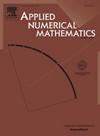Robust globally divergence-free weak Galerkin variational data assimilation method for convection-dominated Oseen equations
IF 2.4
2区 数学
Q1 MATHEMATICS, APPLIED
引用次数: 0
Abstract
This paper presents a weak Galerkin (WG) finite element method based on the variational approach for data assimilation of the unsteady convection-dominated Oseen equation. The WG scheme uses piecewise polynomials of degrees k() and respectively for the approximations of the velocity and the pressure in the interior of elements, and uses piecewise polynomials of degree k for their numerical traces on the interfaces of elements. The method is shown to yield globally divergence-free approximations of the velocity and initial value. It is proved that the velocity error in the -norm has a Reynolds-robust error bound with quasi-optimal convergence order in the convection-dominated region. To solve the discrete optimality system efficiently, the conjugate gradient iterative algorithm is developed, which also preserves the globally divergence-free property of WG scheme. Numerical experiments are provided to verify the obtained theoretical results.
对流占优Oseen方程的鲁棒全局无发散弱Galerkin变分数据同化方法
本文提出了一种基于变分法的弱伽辽金(WG)有限元方法,用于非定常对流占优Oseen方程的数据同化。WG方案分别采用k(k≥1)阶分段多项式和k−1阶分段多项式逼近单元内部的速度和压力,采用k阶分段多项式逼近单元界面上的速度和压力的数值轨迹。该方法可以得到速度和初始值的全局无发散近似。证明了l2范数的速度误差在对流主导区域具有拟最优收敛阶为k+1/2的reynolds -鲁棒误差界。为了有效地求解离散最优性系统,提出了共轭梯度迭代算法,该算法保持了WG格式的全局无发散性。数值实验验证了所得理论结果。
本文章由计算机程序翻译,如有差异,请以英文原文为准。
求助全文
约1分钟内获得全文
求助全文
来源期刊

Applied Numerical Mathematics
数学-应用数学
CiteScore
5.60
自引率
7.10%
发文量
225
审稿时长
7.2 months
期刊介绍:
The purpose of the journal is to provide a forum for the publication of high quality research and tutorial papers in computational mathematics. In addition to the traditional issues and problems in numerical analysis, the journal also publishes papers describing relevant applications in such fields as physics, fluid dynamics, engineering and other branches of applied science with a computational mathematics component. The journal strives to be flexible in the type of papers it publishes and their format. Equally desirable are:
(i) Full papers, which should be complete and relatively self-contained original contributions with an introduction that can be understood by the broad computational mathematics community. Both rigorous and heuristic styles are acceptable. Of particular interest are papers about new areas of research, in which other than strictly mathematical arguments may be important in establishing a basis for further developments.
(ii) Tutorial review papers, covering some of the important issues in Numerical Mathematics, Scientific Computing and their Applications. The journal will occasionally publish contributions which are larger than the usual format for regular papers.
(iii) Short notes, which present specific new results and techniques in a brief communication.
 求助内容:
求助内容: 应助结果提醒方式:
应助结果提醒方式:


